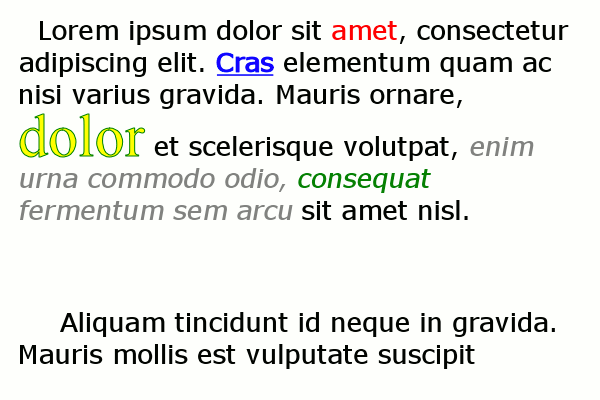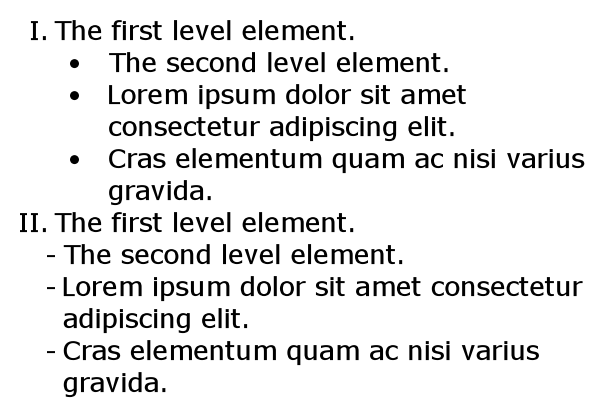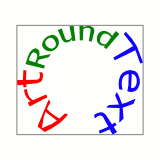Formatted Text
In the Drawing Text topic, we explored how to draw various types of text and modify settings like font, outline, and fill. We also covered text effects and transformations, lists, and OpenType features. This topic addresses how to format portions of text within a single string, such as applying different font styles to specific parts of the text.
Additionally, this topic covers Measuring Formatted Text and Handling Exceptions.
In Graphics Mill, you can format any type of text. Specifically, any child class of Text supports formatting. For demonstration, we'll use the BoundedText class, but the same principles apply to other text types like PlainText, PathText, DoublePathText, and ArtText.
Paragraph and Text Formatting
Text formatting in Graphics Mill uses the <span> and <p> tags with CSS-like style attributes. Here's how it works:
- Mark the text you want to format with
<span>and<p>tags. - Set styles using the
styleattribute. - Initialize a text class with the formatted string.
- Use the class's draw method to output the text.
Here's an example:
using (var bitmap = new Bitmap(600, 400, PixelFormat.Format24bppRgb, new RgbColor(255, 255, 255, 255)))
using (var graphics = bitmap.GetAdvancedGraphics())
{
var brush = new SolidBrush(RgbColor.Black);
var text = @"<p style='first-line-indent:20pt; space-before:30pt; space-after:20pt;'>Lorem ipsum dolor sit <span style='color:red;'>amet</span>," +
@"consectetur adipiscing elit. <span style='bold:true;underline:true;color:rgb(0,0,255)'>Cras</span> elementum quam ac nisi varius gravida. " +
@"Mauris ornare, <span style='font-name:Times New Roman;font-size:60pt;pen-color:green;pen-width:1px;color:yellow;'>dolor</span> et scelerisque " +
@"volutpat, <span style='italic:true;color:gray;'>enim urna commodo odio, <span style='color:green;'>consequat</span> fermentum sem arcu</span>" +
@" sit amet nisl.</p> <p style='first-line-indent:40pt; space-before:60pt; space-after:10pt;'>Aliquam tincidunt id neque in gravida. " +
@"Mauris mollis est vulputate suscipit facilisis.</p>";
var boundedText = new BoundedText(text, graphics.CreateFont("Verdana", 26f), brush)
{
Rectangle = new System.Drawing.RectangleF(20f, 20f, 560f, 360f)
};
graphics.DrawText(boundedText);
bitmap.Save(@"Images\Output\DrawFormattedText.png");
}
This code produces the following image:

You can also use the <br/> tag to insert line breaks.
To display reserved symbols, use the following combinations:
-
&for & (ampersand) -
<for < (less than) -
>for > (greater than)
Paragraph Settings
Configure paragraph settings to control text direction, indentation, and spacing.
| Name | Description | Examples |
|---|---|---|
| direction | Specifies text direction (RTL or LTR). |
style='direction:RTL'
|
| first-line-indent | Indents the first line of the paragraph. |
style='first-line-indent:20pt'
|
| left-indent | Indents the left side of the paragraph. |
style='left-indent:10pt'
|
| right-indent | Indents the right side of the paragraph. |
style='right-indent:10pt'
|
| space-before | Sets space before the paragraph. |
style='space-before:30pt'
|
| space-after | Sets space after the paragraph. |
style='space-after:20pt'
|
| char-style | Specifies the character style for the paragraph. |
style='char-style:bold'
|
| alignment | Specifies the paragraph alignment (left, center, right, justification, justification-last-left, justification-last-center, justification-last-right). |
style='alignment:center'
|
Font Settings
Customize font settings to change the appearance of your text.
| Name | Description | Examples |
|---|---|---|
| font-family | Specifies the font family name. |
style='font-family:Arial'
|
| font-name | Specifies the PostScript font name. If the specified font is not found, the Text.CharStyle font is used. |
style='font-name:LucidaSans'
|
| font-style | Specifies the font style name. |
style='font-style:Narrow Italic'
|
| font-size | Specifies the font size. |
style='font-size:12pt'
|
| bold | Enables bold style. |
style='bold:true'
|
| italic | Enables italic style. |
style='italic:true'
|
| underline | Enables underlining. |
style='underline:true'
|
| leading | Specifies leading. |
style = 'leading:50pt'
|
| tracking | Specifies letter spacing, in thousandths of em. |
style = 'tracking:500'
|
| word-spacing-scale | Specifies word spacing. |
style = 'word-spacing-scale:3'
|
| horz-scale | Specifies horizontal scaling. |
style='horz-scale:120%'
|
| vert-scale | Specifies vertical scaling. |
style='vert-scale:120%'
|
| strike-through | Enables strike-through style. |
style='strike-through:true'
|
| baseline-shift | Adjusts the vertical position of individual characters relative to the baseline of the text. |
style='baseline-shift:0pt'
|
Color Settings
Adjust color settings to change the appearance of text and outlines.
| Name | Description | Examples |
|---|---|---|
| color | Specifies the text fill color. |
style='color:rgb(0,255,0)'
|
| pen-color | Specifies the text outline color. |
style='pen-color:rgb(0,255,0)'
|
| pen-width | Specifies the text outline width. |
style='pen-width:1px'
|
| ink-name | Specifies the ink name for text fill. |
style='ink-name:black'
|
| ink-solidity | Specifies the ink solidity for text fill. |
style='ink-solidity:100%'
|
| ink-color | Specifies the ink color for text fill. |
style='ink-color:rgb(0,0,0)'
|
| pen-ink-name | Specifies the ink name for text outline. |
style='pen-ink-name:black'
|
| pen-ink-solidity | Specifies the ink solidity for text outline. |
style='pen-ink-solidity:100%'
|
| pen-ink-color | Specifies the ink color for text outline. |
style='pen-ink-color:rgb(0,0,0)'
|
Metadata Settings
Use metadata settings to add additional information to your text.
| Name | Description | Examples |
|---|---|---|
| metadata | Specifies metadata attributes for the text. |
metadata='author:John Doe'
|
OpenType Features
The ot format option allows you to apply OpenType features if your font supports them. To disable features, use the minus sign followed by the feature name. Here's an example of drawing formatted text with superscript, small caps, and fraction features enabled:
using (var bitmap = new Bitmap(400, 130, PixelFormat.Format24bppRgb, RgbColor.White))
using (var graphics = bitmap.GetAdvancedGraphics())
{
var brush = new SolidBrush(RgbColor.Black);
var text = @"<p>OpenType Regular Text 1234567890</p>" +
@"<p><span style='ot:sups'>OpenType Superscript 1234567890</span></p>" +
@"<p><span style='ot:smcp;ot:c2sc'>OpenType Small Caps 1234567890</span></p>" +
@"<p><span style='ot:frac;ot:lnum'>OpenType Fractions 1 2/3</span></p>";
var boundedText = new BoundedText(text, FontRegistry.Installed.CreateFont("Lyon Text", "Regular", 24, graphics.DpiX, graphics.DpiX), brush)
{
Rectangle = new System.Drawing.RectangleF(10f, 10f, 380f, 110f)
};
graphics.DrawText(boundedText);
bitmap.Save(@"Images\Output\DrawOpenType.png");
}
This code produces the following text:

For the full list of supported OpenType features, refer to the OpenTypeFeatureTag topic.
OpenType Feature Settings
Configure OpenType feature settings to enable advanced typographic features.
| Name | Description | Examples |
|---|---|---|
| ot | Enables OpenType features. The minus sign followed by a feature name disables this feature. |
style='ot:-liga;ot:sups'
|
| all-caps | Enables all caps style. |
style='all-caps:true'
|
| small-caps | Enables small caps style. |
style='small-caps:true'
|
| small-caps-size | Specifies the size of small caps. |
style='small-caps-size:8pt'
|
| digit-type | Sets the digit type (hindi, arabic, farsi). |
style='digit-type:hindi'
|
Lists
Graphics Mill supports numbered and bulleted lists. Use the <ol> tag for numbered lists and the <ul> tag for bulleted lists. Each list item must be tagged with <li>.
using (var bitmap = new Bitmap(600, 420, PixelFormat.Format24bppRgb, new RgbColor(255, 255, 255, 255)))
using (var graphics = bitmap.GetAdvancedGraphics())
{
var brush = new SolidBrush(RgbColor.Black);
var text = @"<ol style='type:upperRoman;'>" +
@"<li>The first level element." +
@"<ul style='type:bullet; text-indent:30pt; level-indent:50pt;'>" +
@"<li>The second level element.</li>" +
@"<li>Lorem ipsum dolor sit amet consectetur adipiscing elit.</li>" +
@"<li>Cras elementum quam ac nisi varius gravida.</li>" +
@"</ul>" +
@"</li>" +
@"<li>The first level element." +
@"<ul style='type:minus;'>" +
@"<li>The second level element.</li>" +
@"<li>Lorem ipsum dolor sit amet consectetur adipiscing elit.</li>" +
@"<li>Cras elementum quam ac nisi varius gravida.</li>" +
@"</ul>" +
@"</li>" +
@"</ol>";
var boundedText = new BoundedText(text, graphics.CreateFont("Verdana", 26f), brush)
{
Rectangle = new System.Drawing.RectangleF(20f, 20f, 600f, 420f)
};
graphics.DrawText(boundedText);
bitmap.Save(@"Images\Output\DrawFormattedList.png");
}
This code produces the following image:

Configure lists using the style attribute. The type parameter can be one of the following:
For numbered lists:
-
number- Default type with numbers (1, 2, 3, etc.). -
lowerLetter- Lower-alpha (a, b, c, etc.). -
upperLetter- Upper-alpha (A, B, C, etc.). -
lowerRoman- Lower-roman (i, ii, iii, etc.). -
upperRoman- Upper-roman (I, II, III, etc.).
For bulleted lists:
-
none- Default type without markers. -
bullet- Circle marker. -
minus- Minus marker.
Use any symbol by specifying its UTF-8 code, for example:
-
<ul style='type: #9675;'>for circle. -
<ul style='type: #9632;'>for square. -
<ul style='type: #9679;'>for disc.
To start a numbered list with a specific number, use the start argument of the style attribute. For example, <ol style='start: 3; type: upperRoman;'> starts the list from III.
List Settings
Configure list settings to customize the appearance of numbered and bulleted lists.
| Name | Description | Examples |
|---|---|---|
| list-type | Specifies the type of list (none, bullets, numbers). |
style='list-type:bullets'
|
| level | Specifies the level of the list item. |
style='level:1'
|
| number-format | Specifies the number format for ordered lists (none, number, lower-letter, upper-letter, lower-roman, upper-roman). |
style='number-format:lower-roman'
|
| number-mode | Specifies the numbering mode (continue-from-previous, start-at). |
style='number-mode:start-at'
|
| number-start-at | Specifies the starting number for ordered lists. |
style='number-start-at:3'
|
| start | Specifies the start number for a numbered list. |
style = 'start: 3;'
|
| bullet-char | Specifies the bullet character for unordered lists. |
style='bullet-char:*'
|
| bullet-number-pos-alignment | Specifies the alignment of bullet or number position (left, center, right). |
style='bullet-number-pos-alignment:center'
|
| bullet-number-tab-position | Specifies the tab position for bullets or numbers. |
style='bullet-number-tab-position:10pt'
|
| text-indent | Specifies the text indent of list elements. |
style='text-indent:30pt'
|
| level-indent | Specifies the level indent of list elements. |
style='level-indent:50pt'
|
Tab Settings
Configure tab settings to control the alignment and position of tabs within text.
| Name | Description | Examples |
|---|---|---|
| alignment | Specifies the alignment of tabs (left, center, right, character). |
style='alignment:center'
|
| leader | Specifies the leader style for tabs. |
style='leader:dots'
|
| align-on | Specifies the character to align on for character-aligned tabs. |
style='align-on:.'
|
Measuring Formatted Text
Measuring text involves determining the dimensions of a rectangle that tightly encloses the text. To measure formatted text, use the Text.GetBlackBox(FontRegistry, Single, Single) method:
using (var bitmap = new Bitmap(160, 160, PixelFormat.Format24bppRgb, RgbColor.White))
using (var graphics = bitmap.GetAdvancedGraphics())
{
var text = @"<span style='font-size:36pt;color:red;'>Art</span> " +
@"<span style='color:green;'>Round</span> <span style='font-size:36pt;color:blue;'>Text</span>";
using (var roundText = new RoundText(text, graphics.CreateFont("Verdana", 26f), new System.Drawing.PointF(80, 80)))
{
roundText.Bend = 0.9f;
graphics.DrawText(roundText);
graphics.DrawRectangle(
new Pen(RgbColor.Gray, 1f),
roundText.GetBlackBox(graphics.FontRegistry, graphics.DpiX, graphics.DpiY));
bitmap.Save(@"Images\Output\MeasureFormattedText.png");
}
}
This code draws the text and its black box:

Handling Exceptions
The exception classes for formatted text are:
- InvalidStyleValueException - Occurs when there is an invalid style in formatted text.
- UnknownStyleNameException - Occurs when there is an unknown style in formatted text.
- UnknownTagException - Occurs when there is an unknown tag in formatted text.
The following code catches the UnknownTagException error because the <article> tag is not supported:
using (var bitmap = new Bitmap(600, 350, PixelFormat.Format24bppRgb, new RgbColor(255, 255, 255, 255)))
using (var graphics = bitmap.GetAdvancedGraphics())
{
var text = @"<article>Lorem ipsum dolor sit <span style='color:red;'>amet</span></article>";
try
{
var plainText = new PlainText(text, graphics.CreateFont("Verdana", 26f));
graphics.DrawText(plainText);
bitmap.Save(@"Images\Output\DrawFormattedText.png");
}
catch (UnknownTagException e)
{
Debug.WriteLine("The {0} exception message is caught.", e.GetType());
Debug.WriteLine("The unknown tag: " + e.Message + ".");
}
}
The output is:
The Aurigma.GraphicsMill.AdvancedDrawing.UnknownTagException exception message is caught.
The unknown tag: article.